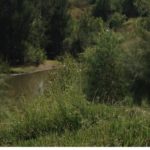This opens up a whole realm of possibilities for using environmental science and illustrates the importance of thinking of traditional infrastructure solutions as a ‘last resort’ rather than a first! This post is by Chris Adam, Director of Strategic AM Pty Ltd, Brisbane, Queensland
 Nitrogen (TN) creates problems in the ecosystem due to the tendency to create algal blooms that can disrupt the food chain. Thirty years ago point source loads (e.g. Sewerage Treatment Plants) were a problem. Who can forget the Sydney beaches of the 1980s when the wind turned onshore? Over the last 20 years we have made huge inroads into resolving these issues. More could be done but we are getting close to the top of the economically rational return to scale. So what ELSE can we do?
Nitrogen (TN) creates problems in the ecosystem due to the tendency to create algal blooms that can disrupt the food chain. Thirty years ago point source loads (e.g. Sewerage Treatment Plants) were a problem. Who can forget the Sydney beaches of the 1980s when the wind turned onshore? Over the last 20 years we have made huge inroads into resolving these issues. More could be done but we are getting close to the top of the economically rational return to scale. So what ELSE can we do?
Queensland Urban Utilities
Queensland Urban Utilities have piloted a couple of nutrient offset projects in which riverbank stabilisation and remediation (leading to a reduction in sediment runoff and therefore TN into the bay). These projects have performed really well (in fact, in the recent torrential rainfall from the tropical low that was once Cyclone Debbie, the sites not only stood up to the challenge but captured sediment!!).
Making a very long story short, the cost of these schemes seem to be in the order of $25,000 per tonne of TN. The current cost of treatment for all EXISTING Wastewater Treatment Plants is in the order of $13,000/Tonne (no surprises here – the return to scale of the existing network is the most cost effective option for removing nutrients). However the cost of augmentation of treatment plants starts at $50,000/tonne. So, what does this mean? We sweat the existing treatment plants (even overloading them hydraulically if necessary) as that’s the cheapest nutrient removal option. However, the next best option seems to be nutrient offsets through land remediation.
There are challenges here in that the regulator will currently only allow offsets against wet weather flow (this is based on the logic that the offset program only removes sediment during rain events which is an assumption that we could debate). The “least best” option is augmentation of the plants (i.e. “hard engineering” that locks in a centralised service model and ignores potential technical obsolescence of the plant itself).
The US EPA have gone further and have set up nutrient trading markets as a mechanism to manage/minimise TN discharge across point and non-point sources of pollution. A similar scheme has been in operation in Lake Taupo in NZ and there are schemes (in the early stages of development) being piloted for the Great Barrier Reef).
What this means is that the water services engineer of tomorrow will definitely have to think beyond the traditional “engineered” solution and understand the issues across a much broader range of inputs/outcomes. It’s very interesting times .

Recent Comments